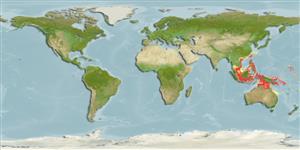Common names from other countries
>
Eupercaria/misc (Various families in series Eupercaria) >
Labridae (Wrasses)
Etymology: Leptojulis: Greek, leptos = thin + Greek, ioulis, a fish dealing with genera Coris or Thalassoma (Ref. 45335); urostigma: From a Greek word meaning 'tail spot', referring to the large balck spot on the base of the caudal fin, its most diagnostic feature..
More on author: Randall.
Environment: milieu / climate zone / depth range / distribution range
Ecologia
marinhas demersal; intervalo de profundidade 7 - 100 m (Ref. 12420). Tropical
Western Pacific: Taiwan, Philippines, Indonesia, and Papua New Guinea.
Tamanho / Peso / Idade
Maturity: Lm ? range ? - ? cm
Max length : 11.0 cm TL macho/indeterminado; (Ref. 48636)
Occurs solitary or in small groups (Ref. 90102) on muddy bottoms, often deep in front of river mouths where land debris is scattered over the bottom; sometimes takes refuge in the mud burrows of other animals. Adults were all seen in about 30 m and usually swim fast near the bottom (Ref. 48636). Feeds on benthic animals (polychaete worms, crustaceans, also small fish) (Ref. 12420). Minimum depth of 7 m from Ref. 90102.
Life cycle and mating behavior
Maturidade | Reprodução | Desova | Ovos | Fecundidade | Larvas
Oviparous, distinct pairing during breeding (Ref. 205).
Randall, J.E., 1996. Second revision of the labrid fish genus Leptojulis, with descriptions of two new species. Indo-Pac. Fish. (24):20 p. (Ref. 12420)
Categoria na Lista Vermelha da IUCN (Ref. 130435)
CITES (Ref. 128078)
Not Evaluated
Ameaça para o homem
Harmless
Utilização humana
Mais informação
ReferênciasAquaculturaPerfil para aquaculturaEstirpesGenéticaElectrophoresesHereditariedadeDoençasProcessamentoMass conversion
ColaboradoresFotografiasStamps, Coins Misc.SonsCiguateraVelocidadeTipo de nataçãoÁrea branquialOutras referênciasCérebrosVisão
Ferramentas
Relatórios especiais
Descarregue XML
Fontes da internet
Estimates based on models
Preferred temperature (Ref.
115969): 26.5 - 29, mean 28 (based on 552 cells).
Phylogenetic diversity index (Ref.
82804): PD
50 = 0.5312 [Uniqueness, from 0.5 = low to 2.0 = high].
Bayesian length-weight: a=0.00501 (0.00207 - 0.01214), b=3.15 (2.94 - 3.36), in cm Total Length, based on LWR estimates for this (Sub)family-body shape (Ref.
93245).
Nível Trófico (Ref.
69278): 3.7 ±0.54 se; based on food items.
Resiliência (Ref.
120179): Elevada, tempo mínimo de duplicação da população menor que 15 meses (Preliminary K or Fecundity.).
Fishing Vulnerability (Ref.
59153): Low vulnerability (10 of 100).
